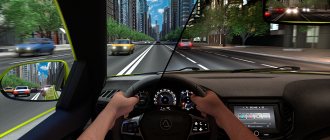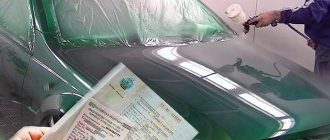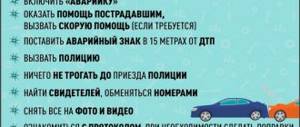Recycling algorithm
Disposal of a vehicle means its safe destruction. Machines are made of metal, plastic, glass, and technical fluids. If you leave it and forget about it, over time, harmful substances will begin to enter the soil and atmosphere.
Recycling involves the safe recycling of vehicles. The car is disassembled by employees of a special organization, the materials are sorted and sent for further processing.
To recycle a car you must:
- Deregister the vehicle with the traffic police. Most scrap vehicle collection points require a certificate of deregistration of the vehicle.
- Drop the car off at a collection point. It is necessary to conclude a disposal agreement with the organization.
There are quite a lot of companies that deal with recycling. The service is provided free of charge. But sometimes a fee is charged for accepting a vehicle with a low mass (less than 800 kg).
To deregister a car you need the following documents:
- Russian passport;
- vehicle registration certificate, vehicle passport, license plates;
- application in the prescribed form;
- The vehicle is not provided for inspection.
Disposal conditions:
- aging and wear and tear of the vehicle;
- The vehicle was sold under a general power of attorney, but the new owner does not appear at the State Traffic Safety Inspectorate to re-register the car in his name (in order not to continue to pay transport tax, the seller of his car has to deal with an extreme measure - the disposal procedure);
- car theft;
- eliminating accidents on the roads due to the difficulty of moving an old car along them.
Remember: if your car has been deregistered by the traffic police, you no longer have the right to drive it. Transport the car only on a tow truck.
Next, you need to visit the traffic police department and get a certificate of deregistration of the car due to disposal.
Conditions for removing a car from state registration:
- recycling according to the state program;
- unlawful actions in relation to a car, theft;
- if the car buyer has not registered the car and does not intend to do so;
- leaving the country for a long time (then the owner registers the car in the country of residence).
Procedure for completing the procedure:
- contact the traffic police in person, join the electronic queue;
- there is no need to deliver the old car to the traffic police for inspection;
- submit the completed application and documents;
- The car owner is given the necessary certificate.
You can then dispose of the vehicle yourself (disassemble and sell for parts) or with the help of a private recycling company.
The conditions and cost of the service are specified in each company separately. Representatives will ask you to provide them with a certificate from the traffic police.
Sample application
Let's look at a sample of filling out an application for recycling a car at the traffic police:
- indicate the exact name of the traffic police department where you are going to submit documents;
- FULL NAME;
- underline the appropriate wording of the reason for deregistration of the vehicle (in connection with disposal);
- fill in the form from the vehicle passport with information about the make, model of the car, VIN number, state signs, year of manufacture;
- enter the passport details of the car owner, fill out information about the owner;
- rewrite the information about the vehicle in the required lines.
Power of attorney for disposal
A power of attorney is a necessary document for deregistering a car if the car owner cannot visit the traffic police department himself. The document must be drawn up correctly.
The power of attorney from a legal entity indicates:
- number, date of compilation;
- full name and address of the organization;
- position, full name of the principal;
- Full name, address, passport details of the authorized person;
- the registration department of the traffic police to which you intend to apply;
- car data (make, license plates, VIN code, year of manufacture, chassis number, body number, engine number);
- car registration certificate, its passport;
- validity period (valid for 1 year);
- signature of the authorized person, principal.
A car owner who wants to scrap a vehicle can only submit a passport and a recycling application. But if for some reason he cannot carry out the procedure himself, he issues a power of attorney to his representative. Then the document is certified by a notary.
A power of attorney from an individual shall indicate:
- place, date of compilation;
- Full name, passport details, address of the principal and authorized representative;
- traffic police registration office;
- vehicle data;
- car passport numbers and registration certificate;
- validity period of the power of attorney;
- signatures of the parties.
Let's look at how to scrap a car under a special program and what documents are needed.
Procedure for obtaining a disposal license
Unlike a license for the use of subsoil, in order to obtain a license for the disposal of vehicles, a citizen does not need to go through a competitive (auction) selection procedure. The first step to obtain permits will be the collection of documents, namely:
- An application prepared according to a template.
- Conclusion of the sanitary-epidemiological service.
- Technical documentation.
- Statements about the entrepreneur or legal entity that applies for a license.
After the documents have been completed and submitted, the supervisory authority reviews them, checks the correctness of execution and the reliability of the data.
If all formalities are met, then they study how the candidate complies with the standards put forward by the state that are prescribed for this type of activity. If everything is in order, the citizen receives a notification that he has passed the licensing procedure.
Government program
This special program was launched in 2010, but is still in effect. The goal of the state program is to increase the growth of sales of domestic cars by providing subsidies for the purchase of new vehicles to replace old ones.
The main condition for participation in the program: you can only spend the funds you receive from handing over your vehicle for recycling to purchase a new car.
Other conditions in 2021:
- you must own the car for at least six months;
- Individuals and legal entities can participate in the program;
- new cars are not scrapped;
- the participant must have a Russian passport;
- a car cannot be recycled without a specially hired dealer (services can cost about 10,000 rubles).
According to the program, you can exchange a passenger car, a large car, a jeep, or a bus. The maximum discount amount is 50-350 thousand rubles.
Minimum amount for cars, maximum for trucks. As part of this program, it has already been possible to sell about 130,000 cars.
Only a limited number of models can be purchased under the program: AvtoVAZ, GAZ, UAZ, several models of Volkswagen, Opel, Nissan, Ford, SsangYong, Renault.
Scrapping with the help of a dealer according to the program
All documents are prepared by the dealer, who also enters into an agreement with the client to purchase a new car.
He issues a discount on the purchase of a vehicle in the form of a certificate or cash. Contact participating car dealers and trade in your old car.
Algorithm of actions:
- draw up a power of attorney for the dealership to transfer the old car to scrap;
- enter into an agreement with the dealer, which states that you are handing over the car to the dealer for deregistration and disposal;
- hand over the power of attorney and the car, receive an acceptance certificate for the car.
The recycling program is only suitable for those who own an old car; no one uses it. You can get quite an impressive amount for it.
The state allocated about 10 billion rubles for recycling . The program has a limited duration, so it is worth applying early.
Conditions for participation in the program
Only the owner, who must own the car for at least 12 months (for Trade-in, six months), can sell a car for a discount. In this case, the age of the car must be at least 10 years (mileage is not important). The year of manufacture is indicated in the technical passport of the vehicle.
Next, the car owner can use one of the program areas: Trade-in or recycling. The first option is the most popular, as it is much simpler to design. The owner just needs to contact a car dealership that uses this system. The discount on a new car is equal to the amount at which the previous one was purchased.
It is important to know! In the case of disposal, the owner must independently contact an accredited collection point, deregister the car, hand it over for scrap and receive a certificate. The state provides a list indicating which cars can be purchased under the recycling program in 2021. The price of the car should not exceed 1,450,000 rubles.
Which brands does it apply to?
The list of cars available under the recycling program is growing every year. On January 16, a new expanded list came into force, indicating which cars can be purchased under the recycling program in 2021. It includes the following makes and models:
- Lada AvtoVAZ;
- UAZ;
- GAS;
- Opel;
- Ssang Yong;
- Peugeot;
- Renault;
- Nissan;
- Volkswagen;
- Citroen;
- Ford;
- Skoda;
- Hyundai;
- Kia;
- Mazda;
- Mitsubishi.
Before contacting, you should clarify whether the car is included in the specified list.
Amount of discount
The discount amount indicated in the certificate depends on the make and type of vehicle. On average, they pay from 40,000 to 175,000 rubles for passenger cars. But there are also exceptions. For example, for a Renault Logan the compensation will be 25,000. The owner can obtain accurate information by contacting a special collection point for recycling vehicles.
It is important to know! The discount on all AvtoVAZ models is 50,000 rubles. For buses, SUVs and special equipment, amounts vary from 90,000 to 350,000 rubles.
If there are no documents, license plates, car
How to dispose of a car without documents and license plates? If you are the owner of a car, you have the right to write it off as scrap only with your passport. Other documents, including license plates, are provided if available.
How to dispose of a car at the traffic police without a car? The practice of selling vehicles has its drawbacks. Quite often, the new owner to whom you sold your car does not seek to pay transport tax, and does not re-register the car in his name within ten days.
Then the invoice for payment of transport tax will come to you, since you will remain the actual owner.
By registering the disposal of your car with the traffic police, you can get rid of unnecessary tax obligations. Go to the traffic police, write a statement of intent to scrap the car.
Afterwards, the car driven by the careless buyer, who refused to re-register the car in his name, will be stopped at the traffic police post, hit the base and sent to the penalty area.
After deregistering a vehicle for disposal, it is impossible to register it again.
History of the project
The car recycling program has existed for quite a long time (since 2010). According to the terms of the project, owners of cars with exhausted service life can count on a significant discount when purchasing a new vehicle.
Initially, the amount of monetary reward did not exceed 50 thousand rubles. The cars purchased were mainly VAZ (more than 80%) and Renault (about 7%). At first, over 500 thousand units of new cars were sold, 30 billion rubles and more than 600 thousand certificates were allocated. Later, the amount of compensation began to be determined based on the classification of cars (for example, for an SUV that was scrapped, the owner could receive up to 90 thousand rubles).
Unfortunately, the project was not supported by the community, as automakers began to raise prices for new cars, and a year later it was officially closed. After a thorough analysis of the automotive market, the program was reinstated in 2014. In addition, 10 billion rubles were allocated to increase production volumes in the domestic automotive industry (Government Decree No. 328 of April 15, 2014 on “Development of industry and increasing its competitiveness”).
Over the seven years of its existence, the program has become popular and is now in great demand among car enthusiasts.
Public services
You can recycle your car using the State Services Portal (https://www.gosuslugi.ru/category). Select “Vehicle registration”, then “Deregistration”, “Deregistration due to disposal”.
The application is completed electronically. Enter the document data into it:
- Russian Federation passports;
- notarized power of attorney (for representatives);
- vehicle passports;
- certificate of registration or technical documentation of a motor vehicle or trailer;
- a document certifying ownership of a vehicle or trailer.
The application should be printed out and taken to the traffic police along with the state registration plates of the car. You need to select a convenient traffic police department, date, time, and make an appointment.
Do not be late for the appointed time, otherwise you may miss the line. Do not forget to take the original documents, the details of which were indicated in the application.
After the employee checks the documents, the vehicle will be deregistered for subsequent disposal.
Is it possible to return a car from scrap?
If the vehicle is not scrapped under the government program, it can be returned. Recovery stages:
- The previous owner of the car must submit an application to the traffic police.
- Draw up a general power of attorney in your name from a notary.
- The vehicle is delivered to the traffic police for technical inspection using a tow truck, since the car has been written off.
- A purchase and sale agreement is concluded with the previous owner.
The process is simple if the parties agree. When there is no certified power of attorney with the right to restore, the car cannot be returned from scrap.
Prices for restoration services:
- registration certificate - 1500 rubles.
- License plates cost 2000 rubles.
- 800 - PTS.
Disposal cost
Do I need to pay a state fee for the procedure? No, this service is provided free of charge.
But you cannot drive a deregistered car. Therefore, you will have to spend money on a tow truck to the car collection site.
According to Law No. 89, licensed collection centers provide recycling services free of charge if a recycling fee has been paid for the vehicle.
But you need to remember that the recycling fee is not paid for vehicles whose title was issued before 2012.
If the fee has not been paid, the owner will have to pay for the service at the company's rates.
Recycling Law as amended 2021: instructions for recycling
To get rid of your old vehicle and receive a certificate for a discount when purchasing a new one, you must do the following:
- Apply to the dealer who has the promotion. You can find out information about this on its official website. Most often, it is car dealerships that deal with such issues.
- If the dealer does not handle recycling, you will have to look for another or do everything yourself. To do this, you must present the vehicle to the recycling center along with documents. An inspection will be carried out and a certificate will be issued based on the results.
- With the certificate, the citizen goes to a car dealership and chooses a new car.
- During the purchase and sale transaction, the cost of transport is paid taking into account the discount.
Only certain car models can be recycled: VAZ, GAZ, Opel, Nissan, Skoda, Volkswagen, Renault, Peugeot, Citroen, Ford. If the brand is not on the list, you will not be able to use the certificate, but you can inquire about the availability of alternative options at car dealerships.
Participation includes cars and trucks that can be recycled and in return receive a certificate for a discount when purchasing a similar type of equipment.
At the moment, the following brands are participating in “Recycling”:
- VAZ;
- UAZ;
- GAS;
- Opel;
- SSangYong;
- Peugeot;
- Renault;
- Nissan;
- Volkswagen;
- Citroen;
- Ford;
- Skoda;
- Hyundai and Kia.
Discounts are provided taking into account the maximum allowable sizes in accordance with car models.
Used car
Is it possible to purchase a used car through a recycling program? New cars are expensive, and discounts for purchasing them through the recycling program are small. But used cars are not included in the program.
The government finances the purchase of only new vehicles, since it supports the main goal of the program: stimulating the sales of domestic manufacturers, who increase the number of cars sold, increasing tax contributions to the budget.
And then the recycling program is financed from it. For this reason, you cannot purchase a used vehicle under the recycling program .
Recycling check
If you are going to purchase a car, do not forget to check it for recycling.
The procedure for deregistration due to disposal is a fairly popular phenomenon among those who want to avoid transport tax on a car that is not in use.
You can check your car for recycling:
- through the traffic police website;
- Autocode;
- various Internet portals.
To check you may need:
- VIN code;
- body/chassis number;
- registration numbers.
Services may fail because sometimes data is not entered into the database. Therefore, checking online is not always a reliable way to find out whether a car has been scrapped, since sometimes vehicles are returned from scrappage. Then contact the traffic police immediately.
Video: Galileo. Car recycling (part 1)
Video: Galileo. Car recycling (part 2)
The main advantages of car recycling through our company
The state program to support the domestic automobile industry and auto recycling has a number of advantages and disadvantages:
- the ability to quickly get rid of an old car, bus, truck and other special equipment;
- the opportunity to purchase a new vehicle for cash and on credit;
- compensation for part of the cost of the car (up to 350 thousand rubles), which makes purchasing cars much more affordable;
- the opportunity to get rid of part of the taxation (even if the car owner does not operate the vehicle for some time, he still has to pay taxes);
- no need to find a place to park and spend the night.
Owners of old VAZs sometimes have to spend a lot of time and effort to ensure they work properly. But in some cases, it is better to buy a new car and rid the yards of clutter, reduce the threat to pedestrians and reduce the toxicity of exhaust on the roads.
All information about participation in the car recycling program in Moscow can be obtained from our contact information. We organize free vehicle removal for individuals, legal entities, vehicle fleets and budget organizations. For any operation, we guarantee full support, assistance in any questions and issuance of all necessary documentation.
Submit your application!
Bottom line
Recycling a car is its safe recycling, which prevents environmental pollution and also eliminates accidents on the roads due to the difficulty of moving an old motor vehicle along them.
To do this, you need to contact the traffic police, taking the necessary documents, and deregister the car.
You do not need to pay a state fee for disposal, but since you cannot drive a deregistered car, you will have to use the paid services of a tow truck to move the car to its destination.
You can also dispose of a vehicle under a special state program.
If you are the owner of a car, but you do not have license plates, documents for the car or the vehicle itself, you can still declare your intention to dispose of your vehicle and deregister it.
You can dispose of the car yourself (by disassembling it, selling it for spare parts) . You can also use the services of a private company.
Download:
Application for disposal of a car in the traffic police - Sample filling.doc
Application for disposal of a car in the traffic police - Form.doc
Recycling of scrap cars
| Material | Material content (% by weight) | ||
| Typical American car | Typical Japanese car | Typical European compact car | |
| Steel and iron | 67 | 72.2 | 65 |
| Plastics | 8 | 10.1 | 12 |
| Glass | 2.8 | 2.8 | 2.5 |
| Rubber | 6 | 3.4 | 6 |
| Liquids and oils | 6 | 3.4 | 2.5 |
| Non-ferrous metals | 8 | 6.2 | 8 |
| Other materials (paint, insulation, electrical wiring) | 4 | 2.2 | 4 |
| Total weight (kg) | 1438 | 1270 | 1210 |
Dismantling
Required for dismantling:
- all operating fluids,
- rechargeable batteries,
- oil filters, fuel tanks, tires,
- catalytic converters,
- airbags and other pyrotechnics,
- lead weights for wheel balancing,
- components containing fluorochlorocarbons,
- certain components containing mercury and lead.
Shredder processing
The goal is to obtain dimensional scrap, ready for use in steelmaking units, with the separation of harmful impurities.
Recycling of scrap car on a shredder includes the following stages:
- removal of light debris by a fan when reloading onto a vibrating conveyor;
- cleaning the air from dust in a cyclone, from where the garbage falls onto a dust conveyor (this conveyor has a magnetic belt separator installed to separate magnetic pieces of scrap);
- garbage from the conveyor goes to the waste collection department;
- heavy non-magnetic debris and non-ferrous metals are loaded onto a conveyor for non-ferrous metals by a second vibrating conveyor;
- Non-ferrous metals are selected by hand and then sent to a warehouse.
After the shredder, the finished meal is melted in a chipboard or converter to produce steel; send non-ferrous metals for melting to non-ferrous metallurgy plants; and the light fraction containing impurities of heavy metals is fed into a blast furnace, where it is possible to separate some metals (lead, zinc) from this fraction, and non-released metals will go into cast iron and then into steel, which will make them safe for the environment.
The use of shredder scrap instead of scrap metal allows you to improve the quality of the resulting metal due to the low carbon content in the scrap (no burning is required) and a negligible content (no more than 1%) of harmless impurities, which reduces the amount of slag in the metal.
Processing of technical liquids
1) Used motor oil is classified as hazardous waste. It should not be disposed of in trash cans, drains or on the ground. Under During the operation of the car, dirt, metal shavings, water and various chemical compounds enter the oil. Used motor oil poses a threat to the environment and humans due to a number of factors:
- it is insoluble, chemically stable and may contain toxic chemicals and heavy metals;
- under natural conditions it decomposes over a long period of time;
- due to its viscosity, it sticks to everything: from sand to bird feathers;
- it is the main source of drinking water pollution. Used motor oil is collected in containers separately from other technical fluids and sent for recycling. It can be processed into new motor oil, lubricating oil, fuel oil or feedstock for the petrochemical industry. For example, one liter of used motor oil can produce the same amount of lubricating oil as 42 liters of crude oil. In addition, recycled motor oil is widely used in asphalt production. The process of recycling used motor oil at a modern processing plant usually includes removing colloidal substances, acid, bitumen, chemical and mechanical impurities, water and gas from it, as well as restoring its color and removing odor.
2) Used coolant/antifreeze , as a rule, has already lost its original properties and is clogged with dirt, rust, metal and wood shavings. Coolant is hazardous to the environment. The process of recycling used coolant, as a rule, includes removing harmful impurities from it, adjusting the chemical composition and restoring the pH level, and adding anti-corrosion inhibitors.
3) Brake fluid is a synthetic motor oil produced using a special formula and used in the hydraulic brake system of a car. Brake fluid is a flammable product containing solvents in the form of a mixture of glycols and various additives. In addition to solvents, used brake fluid contains lead and other heavy metals. Properly collected and mixed brake fluids are typically used as an alternative fuel in various manufacturing processes.
4) Gear oil , used to lubricate transmissions, is a high-temperature flammable mineral oil with low toxicity. Used gear oil contains lead and other heavy metals, making it hazardous to the environment. Recycled into new gear oil.
In Russia, as of January 1, 2009, 1 million 750 thousand tons of motor oils were produced. From them, a potentially minimal amount can be generated annually - about 427 thousand tons of waste oils. Up to 80% of all used oils are illegally dumped on soil and water bodies, no more than 20% is collected, but of all collected used oils, only 14–15% is used for regeneration, and the rest is used as fuel or burned.
Rubber processing
In a typical medium-sized passenger car, approximately 5% (50 kg) of the weight is rubber, mainly represented by tires. According to current data, rubber accounts for up to 20% of the weight of waste buried in landfills in the world.
Of the tires that go out of service each year in the industrialized countries of the European Union, about 25% are retreaded, 20% are burned to produce energy, 10% are processed into crumbs, 5% are used for economic purposes (for example, on farms, as fencing or buffers). devices) and 40% is buried in landfills, and is also thrown away in violation of environmental legislation or stored.
Considering the long period of natural decomposition of rubber, which can be tens of years, an approach to worn tires from a recycling standpoint seems quite acceptable. That is, preference is given to reducing waste generation, reusing for its original purpose, and recycling to recover materials or energy. Only after this should the burial option be considered.
There are a number of ways to reuse and recycle tires to produce other materials and energy: recovery, recycling into crumbs, pyrolysis or burning into cement.
If the tire carcass is in good condition at the time of disposal, then a new tread can be welded onto it. Currently, the market offers quite advanced technologies and equipment that make it possible to increase the service life of tires by 3 or more times. Tires are divided into metal, fabric and rubber, the rubber is crushed in a shredder into crumbs of a given size. The scope of application of crumb rubber is expanding every day. It is currently used, for example, in sports field surfaces, paints, floor mats, tram and railway crossings, speed bumps, waterproofing, soundproofing and roofing materials. However, one of its main areas of application is the production of conveyor belts for various processes. A relatively new and promising area of using crumb rubber on an industrial scale is the production of rubber asphalts. And currently, many economically developed countries, including Russia, are actively testing road surfaces that use crumb rubber. When tires are heated using a special technology without access to air, gas, oil and carbon can be obtained, which are used along with natural resources. When burning tires, approximately the same thermal energy is obtained as when burning coal. Therefore, tires can be used as fuel in cement production, where sufficiently high temperatures prevent the formation of harmful emissions.
Automotive glass recycling
Due to the specific requirements of the automotive industry, each component, as well as the material from which it is made, must be distinguished by functional reliability, durability, presentability, comfort, style, and most importantly, safety. As applied to glass, these requirements include high shock resistance, compliance with the declared crushability coefficient, and complete optical transparency.
Automotive glass is mainly of two types:
- hardened
- laminated
Tempered glass is recycled in much the same way as glass container waste. Laminated windshield presents a certain challenge for the recycler. It consists of several layers of thin glass, between which a transparent thermoplastic polyvinyl butyrate (PVB) is laid. Therefore, dismantling of laminated glass must be done manually. PVB waste is disposed of in the same way as packaging plastic waste. Automotive glass waste is widely used for the production of glass asphalts, abrasives for surface cleaning, reflective additives for paints, bulk substrates in road construction, as well as filter materials, etc.
Plastic recycling
About 10% (100 kg) of a car's weight is plastic, which has some potential for recycling and can therefore be profitable for the recycler. However, to get the most out of this material, a number of challenges need to be addressed. There are approximately 25 types of plastic used in the construction of a typical car, each of which is designed to meet specific, stringent performance requirements. Even the same type can have several varieties depending on the content of filler, additives and dyes.
Most of these plastics cannot be mixed for recycling purposes - hence the question of proper sorting. In addition, a large amount of recyclable plastic is contaminated with metal clips, screws, stickers, foam residue, etc., all of which must be removed before recycling. European and American plastic recycling companies are working successfully to find ways to add value by improving the quality of the recycled material. Based on the results of this work, it has already been determined which materials should be recycled due to their widespread presence in cars, due to the potential market demand for them, and also due to the ability to ensure their guaranteed separation from other materials, and which should not.
The processed materials included:
- Polyester is the material from which seat belts are made.
- ABS (acrylonitrile butadiene styrene) is a hard plastic commonly used in interior linings, steering column covers and instrument panels.
- Polypropylene – A softer plastic used in bumpers, battery housings, some engine parts and interior moldings.
However, it should be taken into account that one ton of plastic parts takes up a fairly large volume (approximately 20 m3, containing 2000 items, excluding bumpers). Here lies another big problem - the high cost of transporting bulk lightweight materials to the place of their processing - which processors have to solve.
It should be recognized that the situation with the collection, sorting and recycling of automotive plastic has improved significantly in recent years due to the adoption by the European Union and a number of industrially advanced countries of laws obliging automakers to label plastic parts on the cars they produce. In addition, significant efforts are being made to reduce the types of plastic used in the automotive industry and unify it among manufacturers. The scope of recycled plastic is constantly expanding. Since today plastic is the most problematic and complex, from the point of view of collection and sorting, waste stream generated during the recycling of automobiles, industrially advanced countries are making large investments in scientific research in the field of creating modern technologies for its processing and use. Below are a number of uses for recycled plastic:
- — production of auto components both entirely from recycled plastic and in combination with new ones; — obtaining flammable gases and diesel fuel from automotive plastic waste;
- - the use of recycled plastic as a carbon source in some; technological processes in ferrous metallurgy;
- — use of recycled plastic in the production of packaging and building materials.











